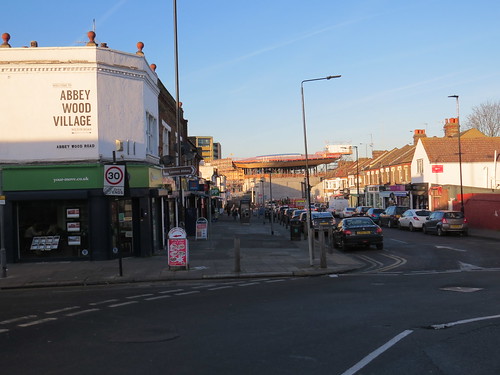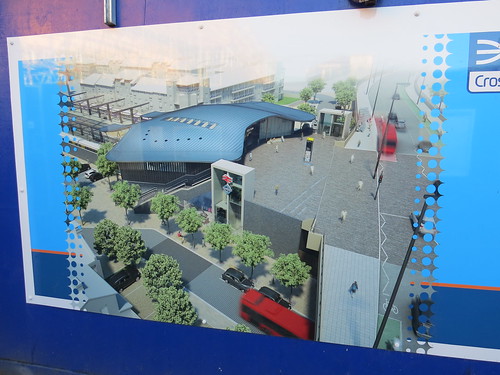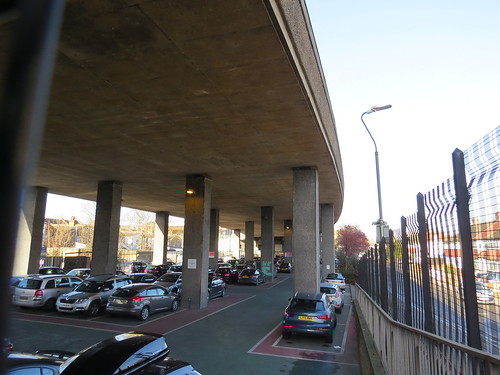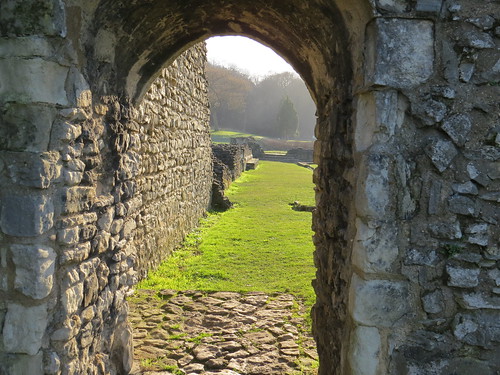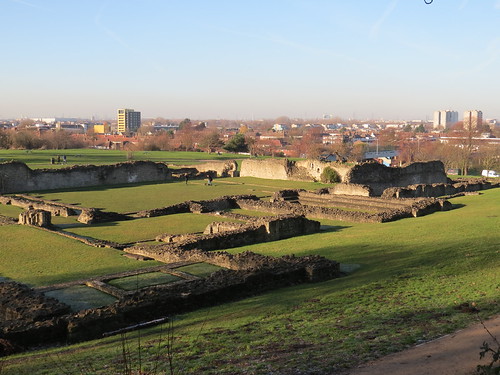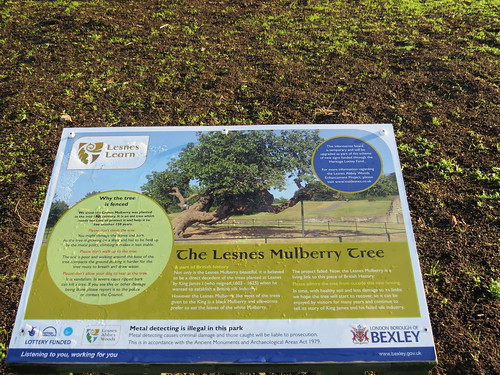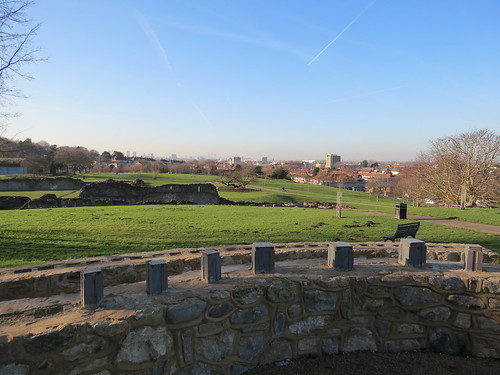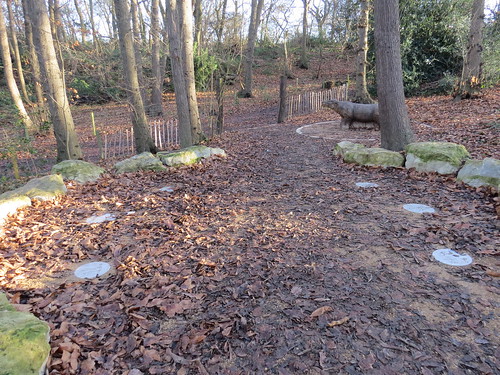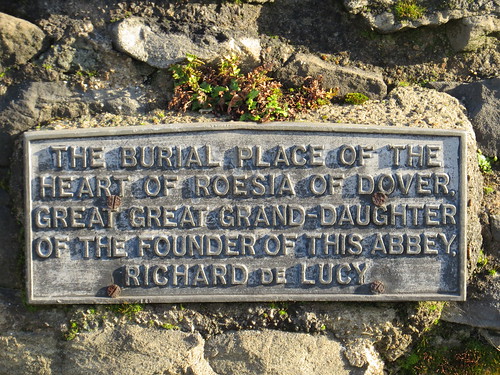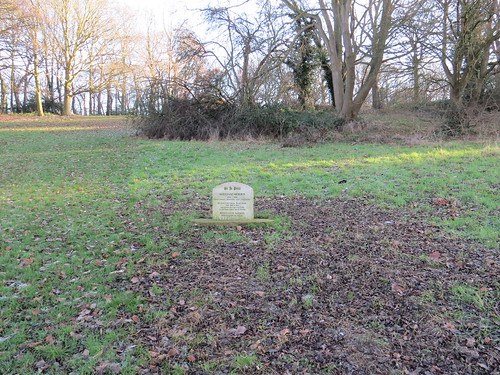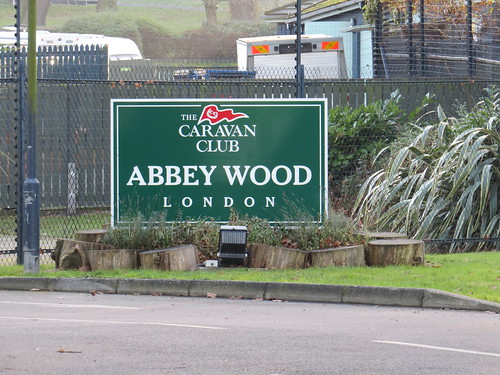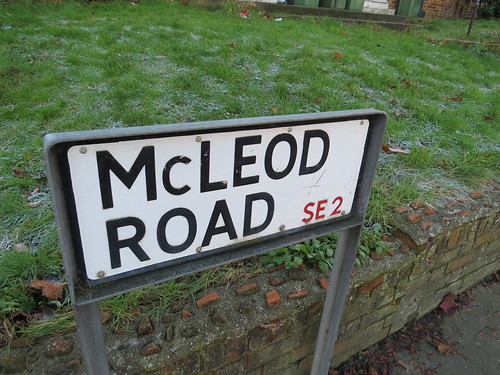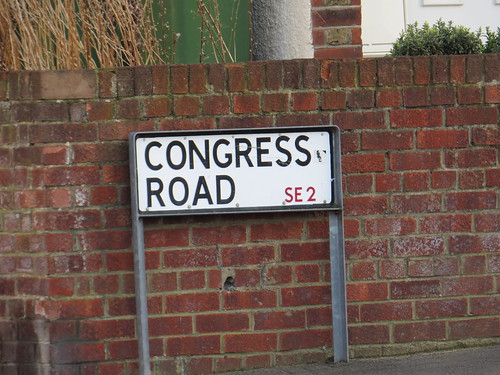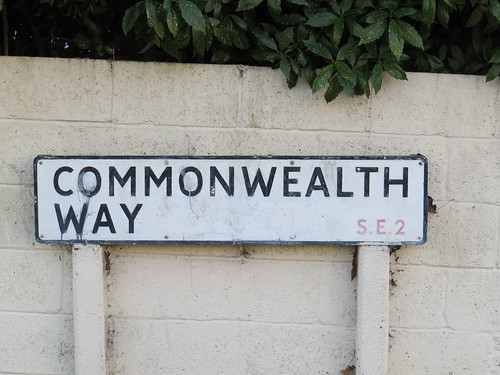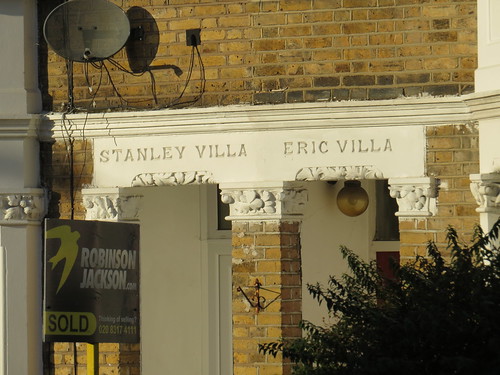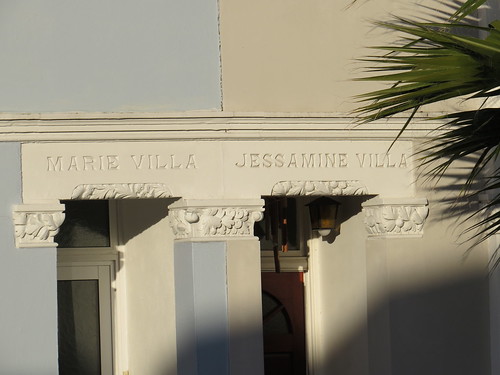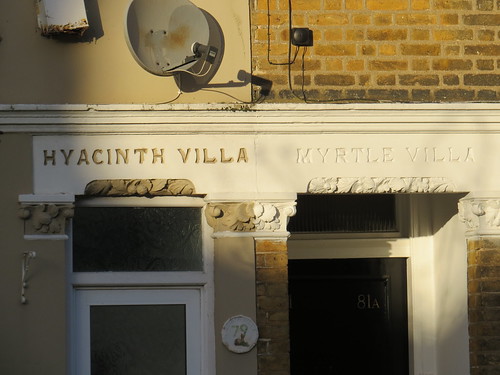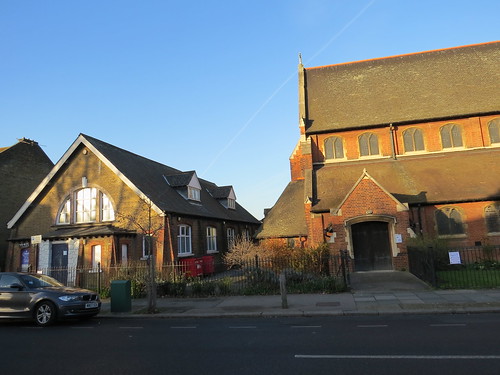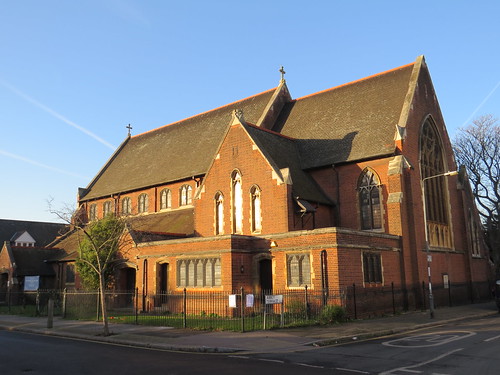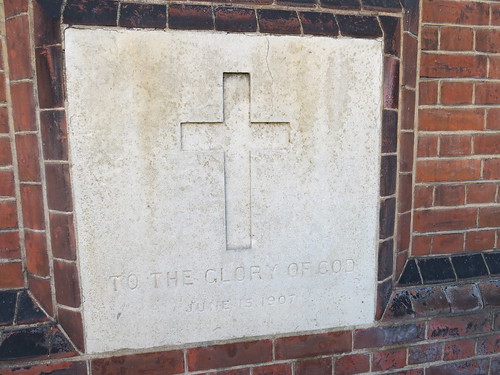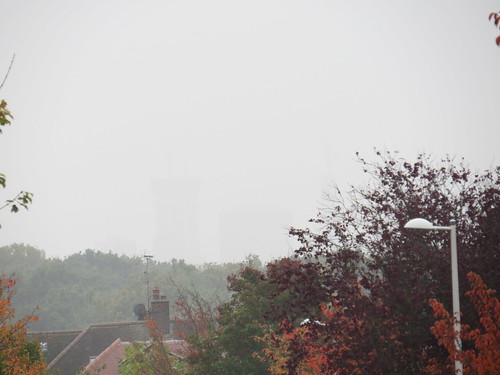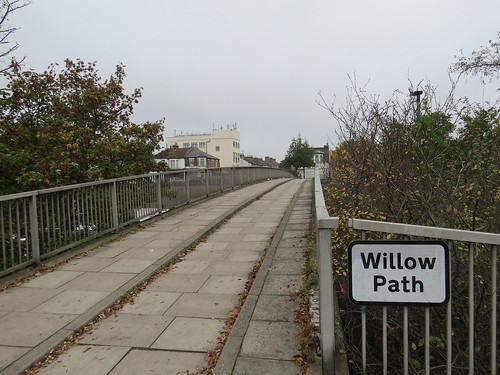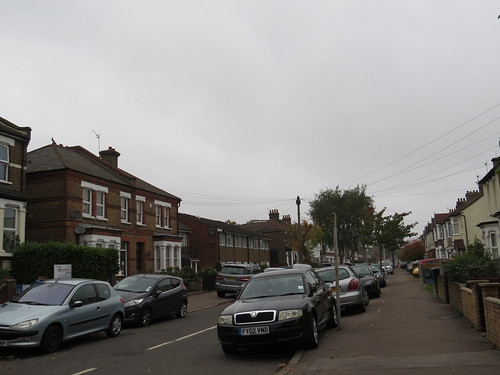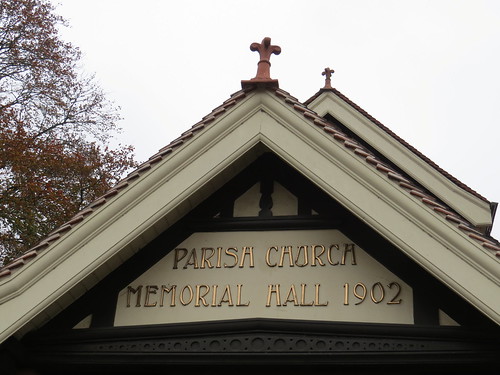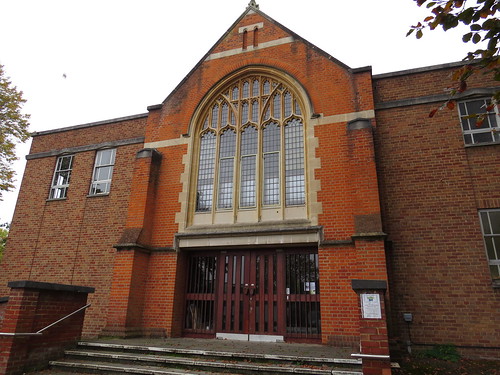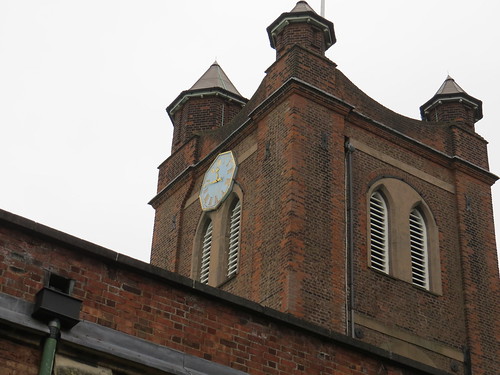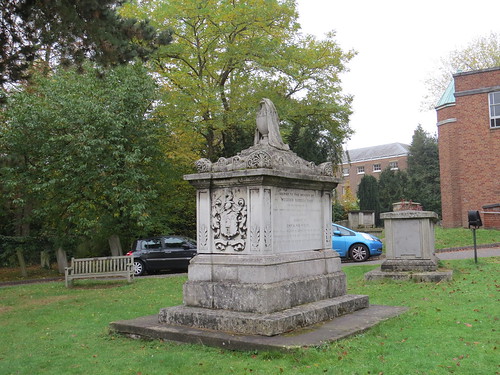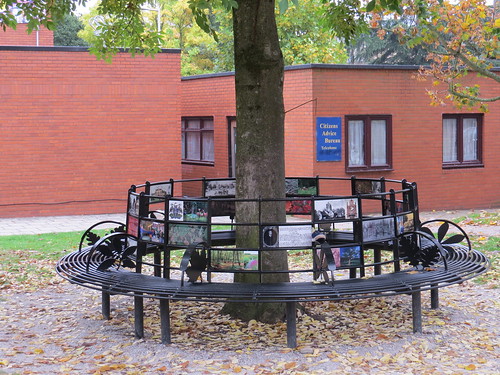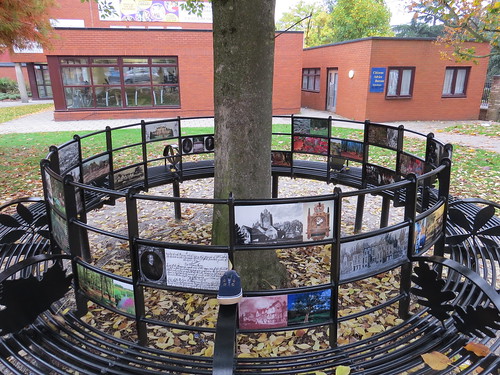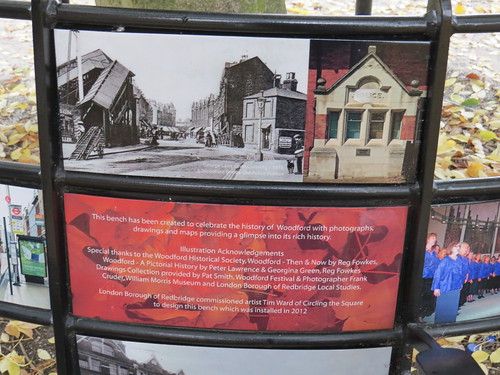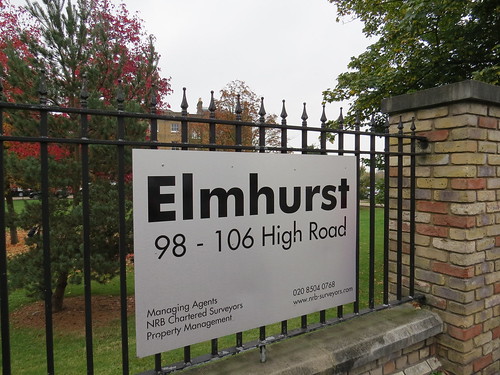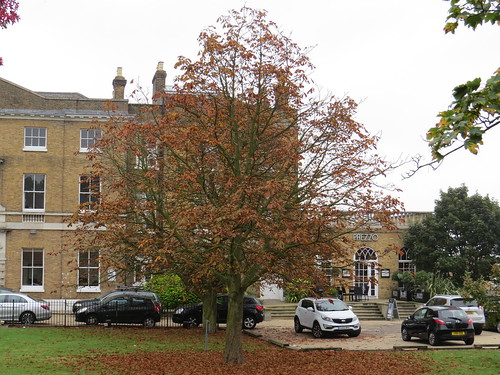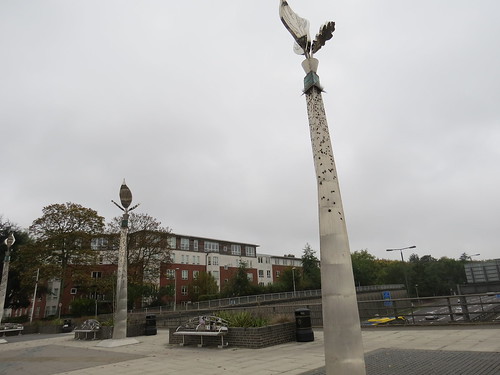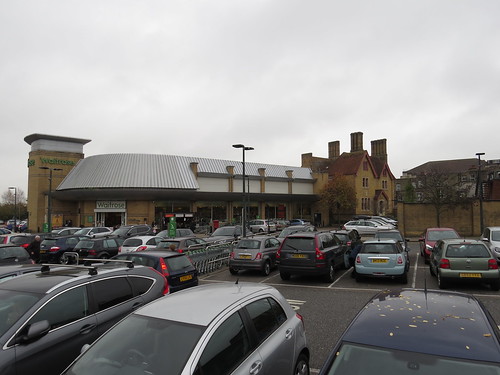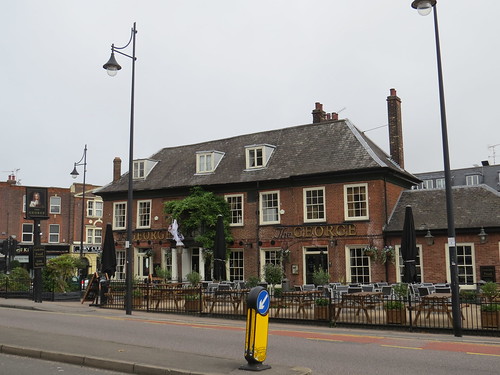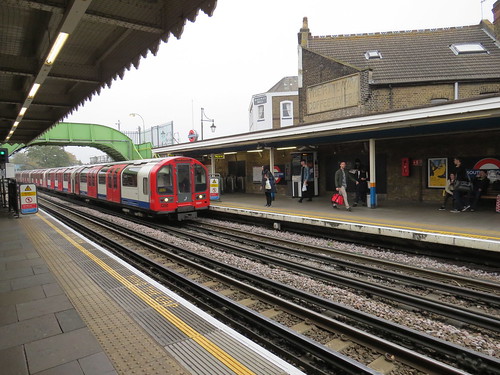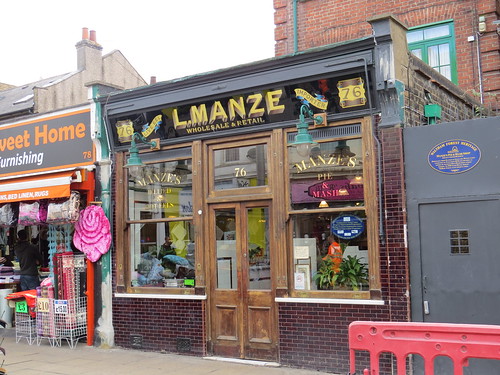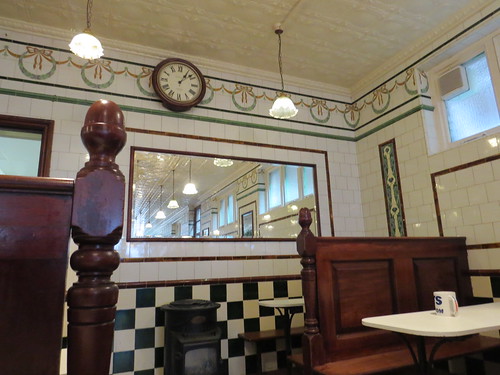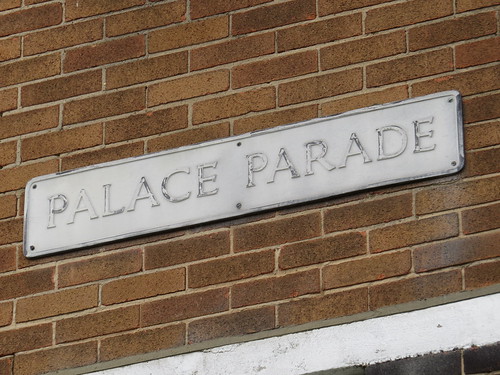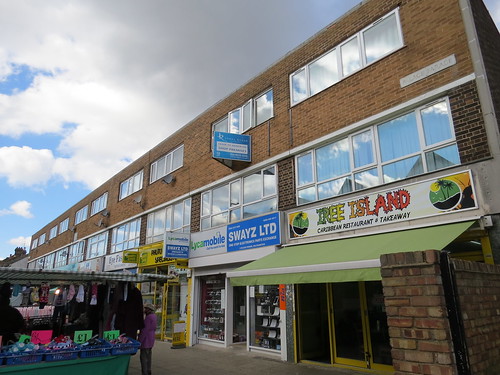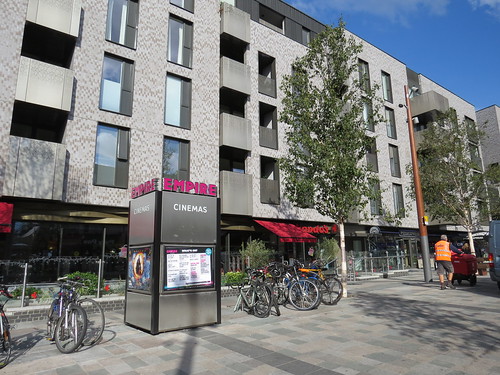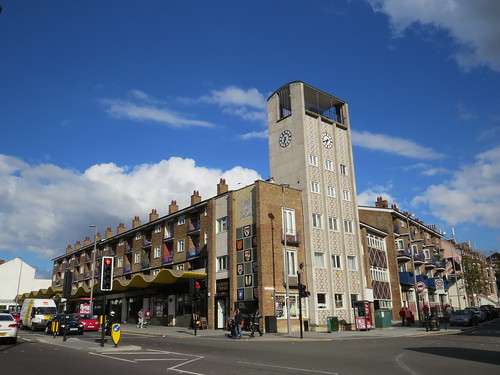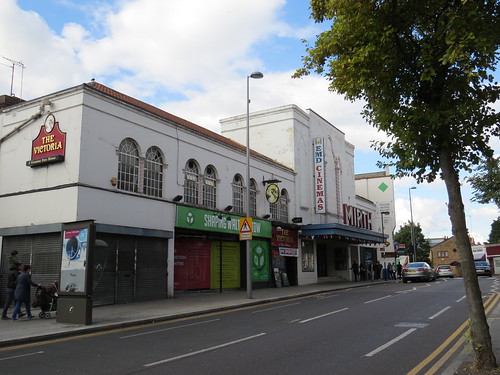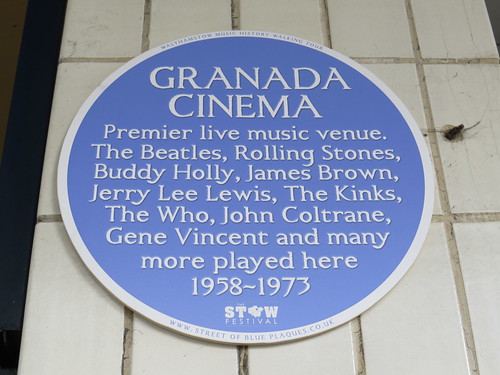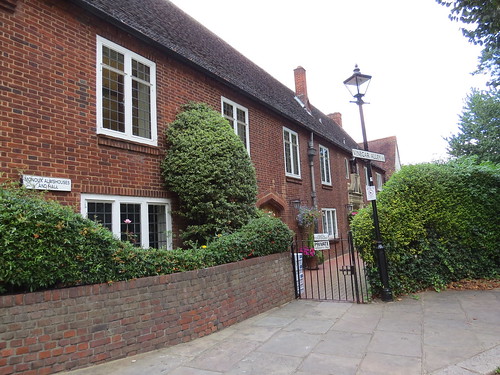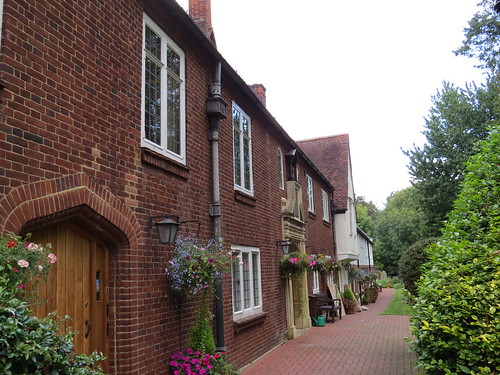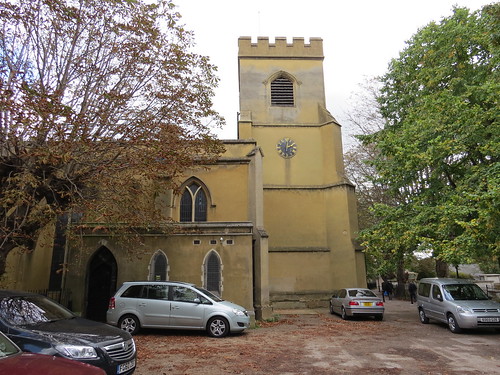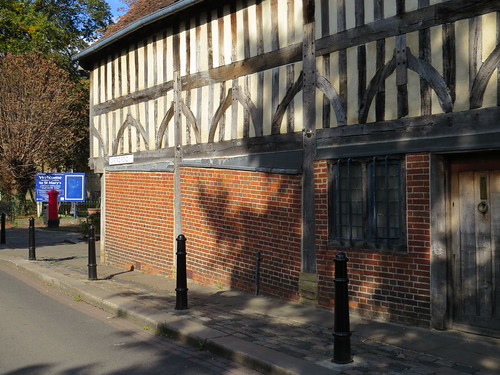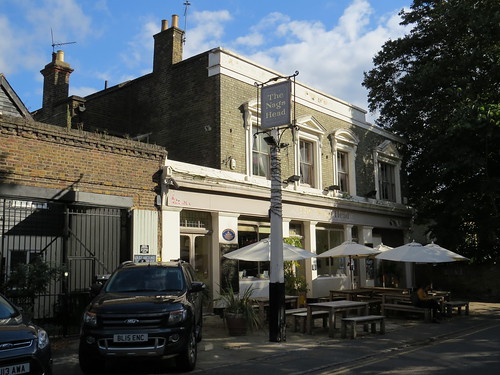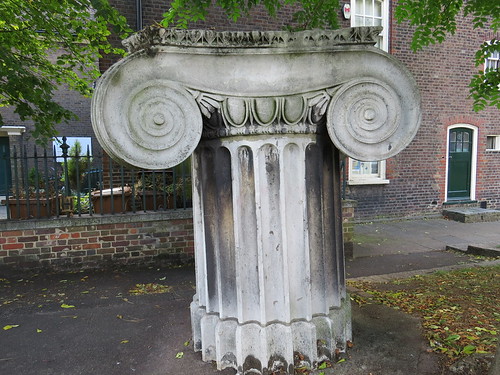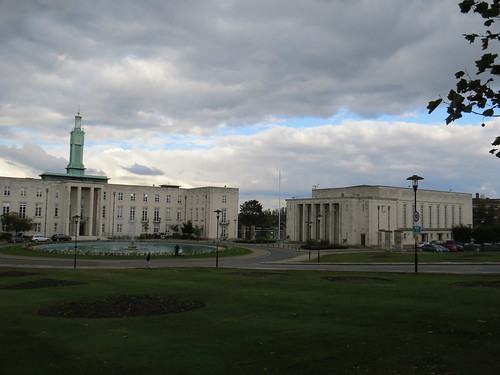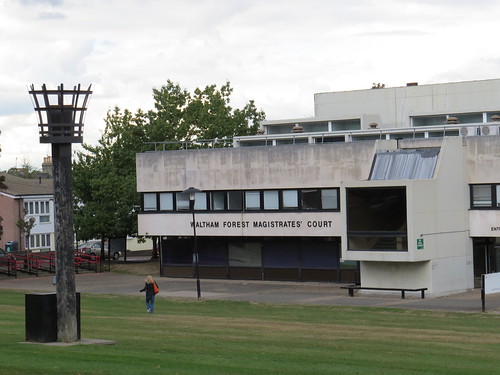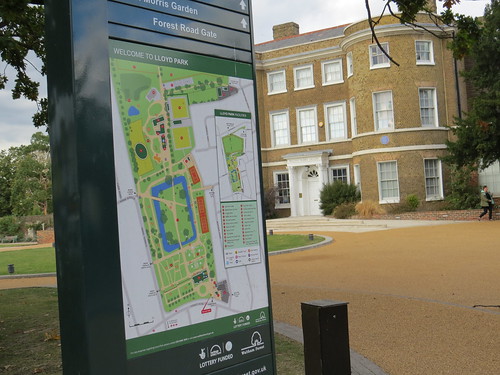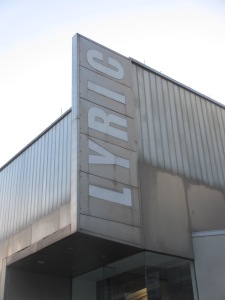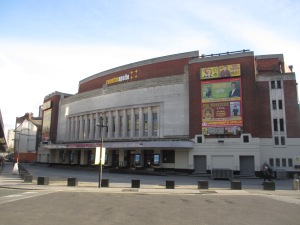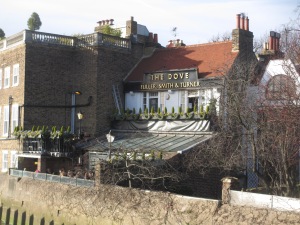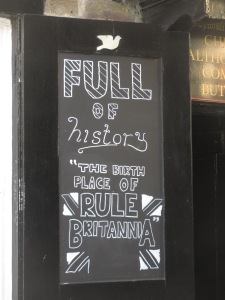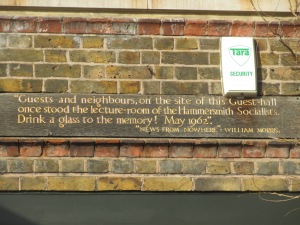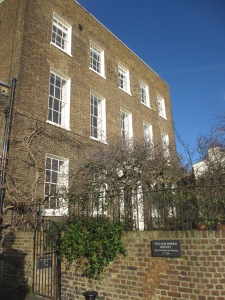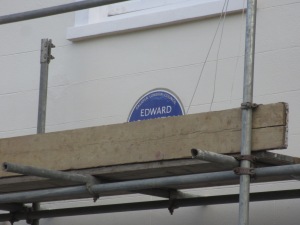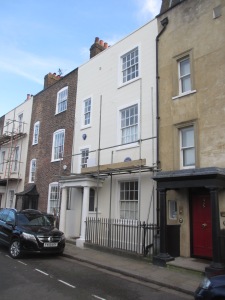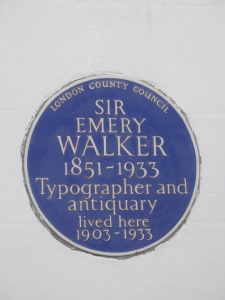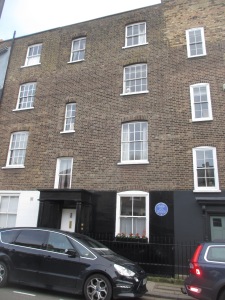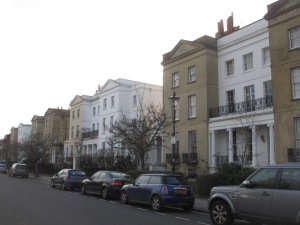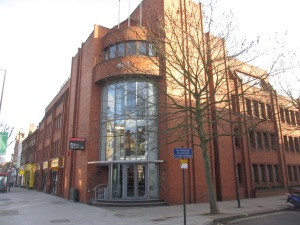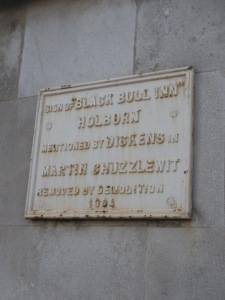SE2 is Abbey Wood. This postcode is actually the furthest east of the London postcodes. The area cannot be said to have much of interest and this is somewhat of a contrast to the previous postcode SE1. But as ever we will find enough to entertain ourselves.
We start our walk at Abbey Wood Post Office, 90 Abbey Wood Road, which is in the heart of what is called “Abbey Wood Village”
Stop 1: Abbey Wood Village
Sadly the reality is a little disappointing. This is not some quaint historic village but a short street of rather nondescript shops. Perhaps the only points worth commenting on is that there seem to be no charity shops and only one empty one. However the selection of shops is somewhat pedestrian.
Then there is a dull looking pub – the Abbey Arms – at the end.
There really is not much to detain us in this “village”. Just beyond the pub is our next stop.
Stop 2: Abbey Wood Station
Abbey Wood railway station was opened in 1849, although there is nothing left to suggest that there was an old station here. It is being rebuilt and will be the end of one of the branches of Crossrail. The new station is emerging and will look quite impressive – it certainly will stand out in this otherwise dull area.
There will be two pairs of platforms by the look of it. On the south side will be the Southeatern services and on the north side will be the new Crossrail services.
It does not look like they have arranged things so there could be a cross platform interchange with Crossrail. This maybe could have been done if Crossrail lines had been placed in the middle. Thus terminating Crossrail trains could have had a cross platform connection with the Kent bound trains and then they could head out and reverse and go back west from the platform adjacent to the London bound Southeastern services. And if they ever extend Cross rail services into Kent that arrangement would make life easier.
Now retrace you steps back through the “village” and turn left by the Post Office and go under the flyover. This is called Abbey Road and goes under a road called Harrow Manorway.
Stop 3: Harrow Manorway
I pause here because this massive flyover and car park beneath seems quite out of keeping with the area.
The flyover carries a road called Harrow Manorway and was built in the 1960s to replace a level crossing when nearby Thamesmead was being developed. Here is a view from above, should you be interested. It feels like it should have been part of a bigger road scheme but it just ends here in Abbey Wood.
Keep walking along Abbey Road. We are heading for Lesnes Abbey. Lesnes Abbey of course is how the Abbey part of Abbey Wood came about.
Ignore the sign pointing to Lesnes Abbey which sends you up New Road. Instead keep going and you will an open space on you left. Ahead is a concrete bridge over the road. This carries the Green Chain walk – a linked system of open spaces between the River Thames and Crystal Palace Park in South East London.
It is here you should leave Abbey Road, by climbing the steps and onto the path leading to our next stop.
Stop 4: Lesnes Abbey
This open space contains the ruins of a 12th century Abbey – the Abbey of St Mary and St Thomas the Martyr founded in 1178 by Richard de Luci (or Lucy)
According to Bexley Council’s website: “De Luci, who had supported Henry II in his dispute with Thomas Becket, which ended with Becket’s murder in Canterbury Cathedral in 1170, probably founded [the Abbey] as an act of penance.”
“Lesnes was not a large or wealthy foundation. Throughout much of its existence, the abbey was in financial difficulties. This was partly caused by the expense of maintaining the river walls and draining the marshes along the banks of the Thames. This reclamation helped transform the land from unusable marsh to valuable pasture. Nevertheless, the abbey gradually built up debts and through the fourteenth century its buildings fell into neglect.”
It never became a large community, and was closed by Cardinal Wolsey in 1525, under a licence to suppress monasteries of less than seven inmates. Lesnes, with only an abbot and five canons, became one of the first monasteries to be suppressed in England. Most of the monastic buildings were pulled down soon after the dissolution, Henry Cooke, who acquired the site in 1541, retained the Abbot’s Lodging for the manor of Lesnes.
It eventually passed to Sir John Hippersley who having salvaged building materials, sold the property to Thomas Hawes of London in 1632. It was then bequeathed to Christ’s Hospital in 1633. They kept it until 1930, when the London County Council purchased it. In 1931 Lesnes Abbey was opened to the public as a park. Ownership transferred to the London Borough of Bexley in 1986.
More info at: http://www.bexley.gov.uk/article/3907/Lesnes-Abbey-ruins
There are a few things to explore here.
Go up to the left and you will see an old Mulberry Tree.
The sign says this was part of a failed attempt during the reign of King James I in the early 17th century to create home grown silk.
And beyond that is a viewing area.
There are plans to provide signage about the park’s history and the landscape beyond and there is going to be what is called “interpretive abbey windows” to “help to help frame to views across Thamesmead, Woolwich, Dagenham and all the way to central and south east London.” There are just the stubs where the “window” will stand but in the distance you can just about make out the towers of Canary Wharf.
In the woods behind, there is a “fossil wood” with a rather splendid carved beast of some kind.
A bit of investigating suggests this is a “Coryphodon” (there is more info about this kind of prehistoric beast on wikipedia if you are interested! https://en.wikipedia.org/wiki/Coryphodon )
I could not see any actual fossils (but maybe I was not looking properly) but they did have some plaques which indications of the kind of fossils I guess were found hereabouts.
It seems you are sort of free to go rummaging round here to look for fossils – subject to certain rules:
http://www.bexley.gov.uk/article/3912/Fossil-bed
Return back to the ruins, which are worth a little wander round. Within the ruins are some signs to indicate what the various areas were used for.
Bexley’s website says: “Rosesia was the great granddaughter of Sir Richard de Lucy, and as a young girl she was raised at Lesnes Abbey… She eventually married and moved away, becoming Roesia de Dover. However, when she died her heart was buried at Lesnes Abbey as a relic to be prayed for in order to speed the passage of her soul through purgatory.”
Beyond the main ruins is an enclosed area which is called the Monk’s Garden, which is being developed with plants typical of when this was a religious establishment.
Now head off towards the new structure with the green roof, which was shut up on my visit but is supposedly a visitor centre of some kind.
Keeping this building to your right leave the open space and turn right into New Road. Go down New Road to the end and turn left back along Abbey Road. Just before the flyover, turn left into Manorside Close and go along the little path head which takes you up to the roundabout where Harrow Manorway meets Knee Hill, which is our next stop.
Stop 5: Knee Hill
Head up the street called Knee Hill but look out over the open space to your left,
You will see a stone plaque (almost opposite the end of Federation Road)
This commemorates a connection with William Morris who lived at the nearby Red House, in Bexleyheath from its completion in 1860 until 1865. Morris regularly walked to Abbey Wood station. He also used a decorated wagon to travel between Abbey Wood station and Red House, Bexleyheath. Clearly this area was then poorly served by train. In fact the line through Bexleyheath (which today provides a nearer station to Red House) only opened in 1895.
By the way “Si je puis” (If I can, in English) was Morris’s motto and can be found in a tile in the porch at Red House.
This, it seems, is the nearest Abbey Wood can get to a blue plaque – and it is not even blue and it only commemorates that someone famous passed by!
Now the name of this place brought to mind that it sounded like it might have something to do with nihilism. In philosophy nihilism is: “the belief that nothing in the world has a real existence.”. Perhaps this is kind of fitting for SE2 which is a kind of uninspiring non-place where the only thing which is deemed worth remembering is something so fleeting that it hardly had any real existence.
Now back in the “real” world, take a right into Federation Road.
Stop 6: Caravan Club
Just along here on the left is a surprising sight – a camping and caravan site which is owned and operated by The Caravan Club.
The Club was founded in 1907 as The Caravan Club of Great Britain and Ireland. Its aim was to “… bring together those interested in van life as a pastime…to improve and supply suitable vans and other appliances…to develop the pastime by collecting, publishing and supplying to members, books and periodicals and lists of camp sites etc… to arrange camping grounds.” Now known simply as the Caravan Club it runs some 200 sites of which this is one of two in Greater London.
Just seems kind of odd to find a place like this here.
Now keep walking along Federation Road
Stop 7: Co-op Estate
The houses here were developed by the Royal Arsenal Co-operative Society (RACS). They owned two farms in the vicinity of Abbey Wood and created the Bostall Estate between 1900 and 1930. The housing is largely traditional terraced houses in yellow London brick, with gardens to the front and rear. This was apparently also known locally as “The Co-op Estate”
The streets are named after Co-operative themes (Alexander McLeod was the first secretary of the RACS, Rochdale was location of the first modern Co-op, Robert Owen is regarded as the father of the Co-operative movement, plus there are streets called Commonwealth, Congress, Conference and Federation). There were some shops but no public houses to tempt the good people of the estate.
By the way I gather snooker champion Steve Davis lived in Commonwealth Way (don’t know exactly where) and went to Alexander McLeod Primary School and Abbey Wood Secondary School.
In the late 1950s the London County Council built the Abbey Estate starting with one road south of the railway and later extending on the northern side on former RACS marshland. The later in the mid-1960s the Greater London Council began building the first phase of Thamesmead on more ex-RACS land, north-east of Abbey Wood station. But that is now in SE28, so we will have to save that for a future date.
Now take a right down Shieldhall Street and ahead on the other side of McLeod Road is our next stop.
Stop 8: Greening Street Green
My eye was drawn to the open space ahead which is known as Greening Street Green.
It is a sad space imprisoned in a high wire mesh fence. Not at all inviting. It is almost as if the Council want to stop people using this. No doubt in the past it seemed a good idea to have this high fence stop balls escaping and dogs entering. But it really could be done better.
At the end of Shieldhall Street, I found our next stop.
Stop 9: Numbers 71 – 81 Abbey Wood Road
Facing on to Shieldhall Street and Greening Street are six terraced houses with names. They have the delusion of grandeur in that they are all “villas” despite being quite modest terraced houses.
Starting on the left there is Stanley and Eric.
And then there is Marie and Jessamine.
And finally Hyacinth and Myrtle.
Presumably these were relatives (or maybe friends) of the developer or builder. These people may have been so proud or honoured to have a house named after them. Their names live on it over the doorways of these six houses but who they were and why their names were chosen is I guess lost in the mists of time.
Walk along Abbey Wood Road as if you had done a right out of Shieldhall Street. Our next stop is ahead on the left
Stop 10: St Michael and All Angels Church
Architectural expert Pevsner normally so effusive in the description of churches simply mentions the existence of this one.
St. Michael and All Angels Parish Church opened in a temporary building in 1905. The permanent church, designed by well known church architect Sir Arthur Blomfield, was consecrated in 1908, and the original building became the church hall, which can be seen at the western end of the church…
Unusually for a church of this period the foundation stone is modest in the extreme.
It does not even have a name, just saying “To the Glory of God June 15 1907”.
So that brings us to the end of our SE2 walk – well sort of.
Postscript
There is one thing which is really worth a visit in SE2 but it is a little too far to go to. That is the Crossness Pumping Station – a piece of wonderful Victorian engineering which was a key part of the sewage system created by Sir Joseph Bazelgette (1819 – 1891) in the 1860s.
Crossness is at the eastern end of the Southern Outfall Sewer and the facility included storage tanks and an engine to pump out the sewage on the falling tide.
The Beam Engine House is a Grade 1 Listed Industrial Building constructed in the Romanesque style and features some spectacular ornamental Victorian cast ironwork. Today the Engine House is open for visits but the times are limited. See attached link:
http://www.crossness.org.uk/visit.html
A word of warning – according to TfL Journey Planner, the nearest bus stop to the Crossness site is some 28 minutes walk away. So probably best to use your own transport if you want to visit.
Well that really brings us to the end of our SE2 walk. Not the most inspiring postcode but even so it had the remains of a medieval abbey and a reminder that William Morris passed through here on the way to his house.
Assuming you did not go to Crossness you will see that you are virtually back to Abbey Wood station for onward travel.


